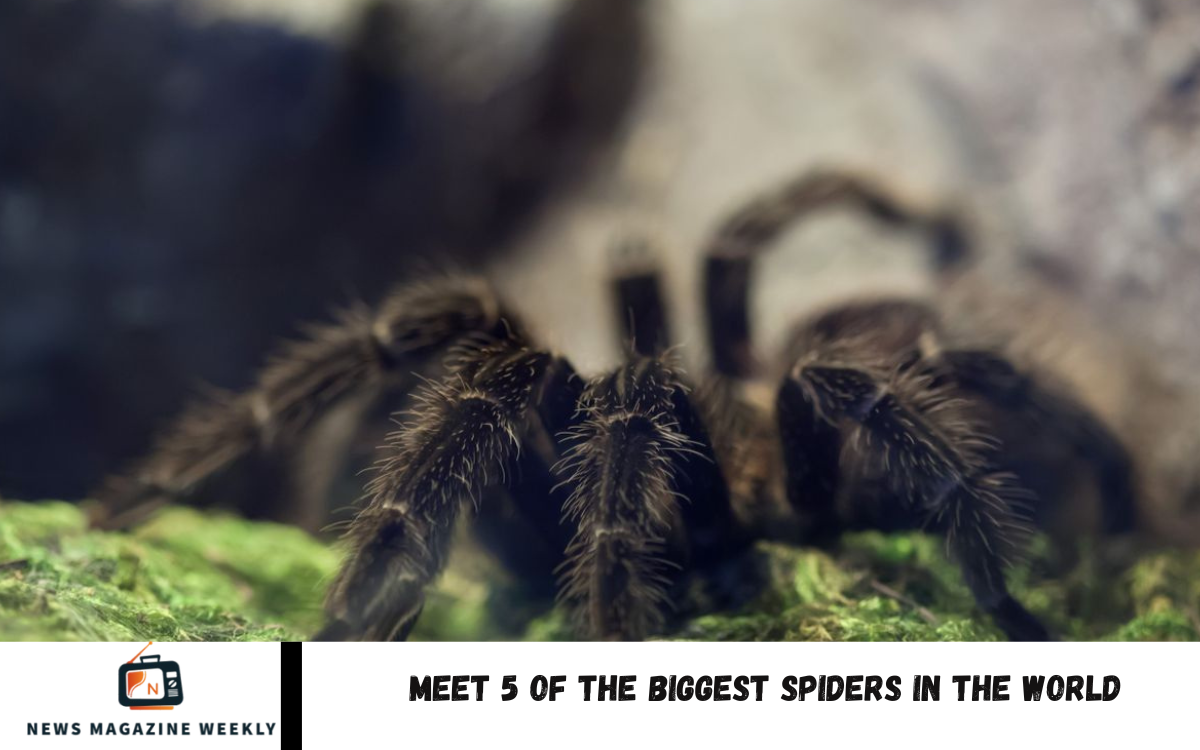Spiders are some of the most fascinating yet fear-inducing creatures on the planet, with over 45,000 known species, these arachnids, and behaviors. While most spiders are small and harmless, some grow to astonishing sizes, making them the stuff of nightmares for arachnophobes.
In this article, we’ll introduce you to five of the most enormous spiders in the world—species that stand out due to their massive leg spans, impressive body sizes, and unique hunting abilities. From the Goliath Birdeater, which can rival the size of a dinner plate, to the Giant Huntsman Spider, known for its long, sprawling legs, these arachnids are both awe-inspiring and spine-chilling.
Despite their intimidating appearance, most of these giant spiders pose little to no threat to humans. Many rely on their sheer size and strength to hunt insects, small rodents, and even birds. Whether you admire their role in nature or find them terrifying, these oversized spiders are undeniably remarkable creatures.
What Are the Largest Spiders in the World?
Spiders come in all shapes and sizes, but some species grow to genuinely gigantic proportions. The enormous spiders in the world are measured based on two key factors: leg span (the distance from the tip of one leg to the tip of the opposite leg) and body size (the length of their body without legs).
Among the biggest spiders ever recorded, the Goliath Birdeater (Theraphosa blondi) is the heaviest, weighing up to 175 grams (6.2 ounces). Its body length is about 5 inches, and its leg span is 11 inches. The tarantula family is found in the rainforests of South America.
Another giant is the Giant Huntsman Spider (Heteropoda maxima), which has the largest leg span of any spider, measuring up to 12 inches (30 cm). This species, discovered in Laos, is known for its incredible speed and hunting skills.
How Do These Spiders Grow So Big?
The massive size of the world’s most enormous spiders is the result of a combination of evolution, habitat, and biological adaptations. Unlike most small spiders, these giants have evolved to thrive in specific environments where larger body sizes provide survival advantages.
Evolutionary Adaptation
Over millions of years, some spider species have adapted to growing more significantly to improve their ability to hunt and defend themselves. Bigger bodies allow them to capture larger prey, including insects, small rodents, birds, and amphibians.
Habitat and Climate
Many of the enormous spiders are found in warm, humid environments, such as the rainforests of South America, Southeast Asia, and Africa. These habitats provide the perfect conditions for growth, including abundant food sources and stable temperatures that support their long lifespans.
Molting Process
Spiders grow through molting, a process in which they shed their exoskeleton multiple times throughout their lives. The more times a spider molts, the larger it becomes. Giant spiders, such as tarantulas, can molt more than ten times before reaching their full size, which can take several years.
Diet and Nutrition
A protein-rich diet plays a crucial role in their growth. Giant spiders consume not just insects but also small mammals, lizards, frogs, and even birds in some cases. The availability of high-protein prey contributes to their ability to reach massive sizes.
Long Lifespan
Some tarantulas, like the Goliath Birdeater, can live up to 20 years in the wild, allowing them ample time to grow bigger with each molting cycle.
By combining these factors, giant spiders have managed to dominate their ecological niches, proving that size truly does matter in the world of arachnids!
Read Also: Are Sea Monsters Real – The Truth Behind These Famous Sea Legends
The 5 Biggest Spiders on Earth
The world’s most enormous spiders are known for their massive leg spans, heavy bodies, and incredible hunting skills. Here’s a closer look at the five most considerable spiders ever recorded:
1. Goliath Birdeater (Theraphosa blondi) – The Heaviest Spider
- Size: Up to 11 inches (28 cm) leg span
- Weight: Up to 6.2 ounces (175 grams)
- Habitat: Rainforests of South America
- Fun Fact: Despite its name, this tarantula rarely eats birds—it mainly preys on insects, frogs, and rodents.
2. Giant Huntsman Spider (Heteropoda maxima) – The Longest Leg Spa
- Size: Up to 12 inches (30 cm) leg span
- Weight: Lighter than the Goliath Birdeater
- Habitat: Caves in Laos
- Fun Fact: This spider doesn’t build webs—it hunts down its prey with speed and agility.
3. Brazilian Salmon Pink Birdeater (Lasiodora parahybana)
- Size: Up to 10 inches (25 cm) leg span
- Weight: Around 3.5 ounces (100 grams)
- Habitat: Forests of Brazil
- Fun Fact: It’s one of the most popular giant tarantulas in the pet trade due to its size and striking pink hair.
4. Colombian Giant Tarantula (Megaphobema robustum)
- Size: Up to 9 inches (23 cm) leg span
- Weight: Moderate but heavy-bodied
- Habitat: Rainforests of Colombia and Brazil
- Fun Fact: It has a defensive trick—spinning in circles to scare away predators!
5. Face-Sized Tarantula (Poecilotheria rajaei)
- Size: Up to 8 inches (20 cm) leg span
- Weight: Lighter but very fast and venomous
- Habitat: Sri Lanka and India
- Fun Fact: Discovered in 2009, this spider can be as large as a human face!
These giant spiders may look terrifying, but most of them are harmless to humans and play an essential role in nature by controlling insect populations. Which one do you find the most fascinating?
Frequently Asked Questions
How long do these giant spiders live?
Many large spiders, especially tarantulas, have long lifespans—some females can live up to 20 years in captivity.
Can people keep these giant spiders as pets?
Yes! Some species, like the Brazilian Salmon Pink Birdeater, have size and manageable temperament.
How do giant spiders catch their prey?
Most do not use webs to catch food. Instead, they ambush or chase down their prey, using their strong legs and fangs to subdue it.
What is the scariest-looking giant spider?
The Face-Sized Tarantula (Poecilotheria rajaei) is one of the most fearsome-looking due to its large size and fast movements.
Why are these giant spiders important to nature?
They populations, maintain ecological balance and serve as food sources for larger predators in their environments.
Conclusion
The world’s most enormous spiders might appear frightening at first, but they are remarkable creatures that serve an essential role in nature. From the Goliath Birdeater, the heaviest spider on Earth, to the Giant Huntsman Spider, with its record-breaking leg span, these arachnids showcase the incredible diversity of the spider world.

